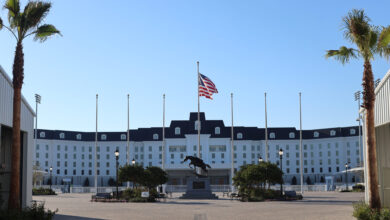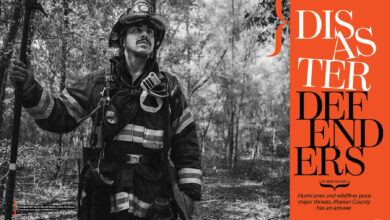Story: Keith Chartrand | Photography: Chris Redd
The following is a historical account of the Ocala City Auditorium through its own eyes. The information in the story was provided by former Ocala Star Banner editor David Cook, various January 1936 editions of the Ocala Evening Star Newspaper and a 2008 Villages Daily Sun article.
For all 78 years of my existence, the sun from the morning’s eastern sky would greet me, illuminating my front doors. Its warmth felt wonderful. Being located on the extreme northeast corner of Tuscawilla Park certainly had its disadvantages over the years. Being over a mile from the city square nearly cost me my existence several times. To say that I made the most of time here in Ocala couldn’t be further from the truth. Truth is, I’ve had only 20 good years here, and 20 years I could smile back at the sun each morning. The other 38, were hard to know what to think of my existence. I wasn’t sure of my purpose. Lack of care and attention drove me into a very dark period for quite some time. Even sunny days couldn’t change what I felt inside. Now, after 78 years, word has come I’ll have a purpose again, along with care, attention and a major overhaul of my interior. New life is coming! I once was the Ocala City Auditorium. Over the course of the next 17 months I will become the Reilly Arts Center. I’m ready to thrive once again and bask in the Ocala sun!
A copy of the Ocala Evening Star newspaper told the news and painted a picture of Ocala life in January 1936, several months before I was even conceptualized by my architects and engineers. A & P Markets, located just to the south of my future location at Magnolia and Main Streets, advertised a 14 ounce loaf of bread for 6 cents. Octagon-shaped soap chips, an 18 ounce pack, would set Ocalians back 15 cents. Fresh dressed and drawn hens were 29 cents while baby beef steak round was 20 cents a pound.
Instant Postum, the 30’s version of decaf coffee, was 23 cents for a 4 ounce can. Turnipseed Motor Company, located at the corner of Jefferson and Magnolia, claimed they had the cream of the market for cars. A used 1935 Chevy 4-Door Deluxe Sedan ranged from $265 to $585. That Chevy could be filled-up and worked on at the Standard Oil Filling Station. Prescriptions could be filled and beauty aids bought at Bitting Drug Store. Sam T. Wilson’s Jewelry Company, at 110 East Broadway, wanted your old gold, and the two city theaters, the Ritz and the Dixie, were showing the latest movies and hosting traveling shows like the Barn Dance Frolics.
In this post-depression era, Ocala was beginning to get back to life. The Christmas holiday of 1935 brought more tourists to Silver Springs than the chamber of commerce expected. More visitors came weeks later, on January 18 and 19, for the Mid-winter conference of the Florida American Legion. The Evening Star detailed how visitors would enjoy big entertainment programs planned at the Hotel Marion and the “glass-bottom boats (of Silver Springs) will attract many visitors.” On the 24th, Ocala mayor Bradford C. Webb planned for a festival of progress parade. Miss Mary Louise Sheppard would ride in the parade as Miss Ocala.
Yet getting Ocala, the state of Florida and the entire country completely out of the Great Depression was just getting started. Making the front page of the Evening Star on a daily basis all of January and months beyond were updates on the building of the Cross Florida Barge Canal. A years’ worth of construction had taken place to create a waterway connecting the St. John’s River in Palatka to the Gulf of Mexico at Cedar Key. From the northern-most point of the St. John’s River at the Atlantic Ocean, the canal would link Florida’s inland waterways to both coasts. The canal would boost the state’s economy while saving travel time and distance for shipping companies by avoiding the much longer route around the southernmost part of the Florida peninsula. Florida politicians lobbied and convicted then-president Franklin Delano Roosevelt to allocate $5 million for the project. Plans included digging from the Ocklawaha River, near the intersection of CR 315 and SR 40, in a southwest direction through Belleview, across Interstate 75 and then due west at the intersection of SR 200 and CR 484.
Ocala was very much in the middle of the “Big Dig” process. On January 17, the man who ran the day-to-day operations of the canal dig met with Marion County Chamber of Commerce members and Ocala residents at the Hotel Marion. Brig. General Sumpter Lowry Jr., stomped for public support of additional canal funding saying, “If you want to see prosperity, fight the fight.” The next day the American Legion members visiting from around the state would, in fact, also be working on the canal.
Four new projects or classes, coordinated between the county and the school district, were going to be offered to Ocala residents: vocational work, general education, home-making and colored literacy classes.
Unlike adult education classes, getting infrastructure built, like myself, had to go through a lot of political red tape. While the canal got the headlines around the state, the wrangling over an Ocala WPA infrastructure project involving the construction of Major League Baseball field and grandstand seemed to be at a standstill. In a Letter to the Editor in the January 20 edition of the Banner, Otto Wettstein III, chairman of the Ocala Planning and Recreation Committee, explained the reason for the standstill despite Washington approving the athletic field in the summer of 1935.
The Feds provide one-third of the money, giving the state to select the projects which are most important to the state. The money sent to Florida is divided by counties in proportion to population. It cannot be confirmed the $7,500 once allocated for the baseball stadium was used for part of my $62,000 construction cost, but mid-way through 1936, I was approved for existence. I had hurdles to get over as well. The Evening Star reported that downtown merchants, carrying a lot of clout with county commissioners, wanted me to be placed on Osceola Street at Broadway to enhance their bottom line. Others wanted me with all the other WPA projects at Tuscawilla Park. Months and months of bantering at city council meetings kept delaying my groundbreaking. Once constructed, there was a lot of celebrating. I brought possibilities to the city and was viewed as a huge asset. The chamber of commerce made me its No. 1 priority.
My first 15 years were vibrant. Weekend dances featuring big band era performers brought in the locals and others from surrounding towns. The biggest blowout event during my early years was the annual New Year’s Eve Ball. Patrons enjoyed the sounds of top-notch entertainment. Dean Hudson, a Florida native who later became a household name in the music industry, played as the ball dropped. The sound of his trumpet bouncing off my walls choreographed the dancers steps as they celebrated the arrival of the new year. As much as it was nice to have Hudson, when the talented saxophonist Glen Gray and the Casa Loma Orchestra came to town for another New Year’s Eve celebration, I felt like a million dollars. Gray and his orchestra were considered one of the best touring dance bands in the country. They turned every inch of my 14,800 square feet into a swinging party. To this day I can still hear “Casa Loma Stomp,” “Maniac’s Ball” and “No Name Jive.”
When I wasn’t ringing in the New Year, the boys on liberty from Camp Blanding up in Starke would come down. The local Ocala ladies were always happy to provide them with some company. During World War II, the Army base was used in many capacities. It served as an infantry replacement training, a German prisoner-of-war compound, and a holding center for US immigrants. For five years, 1940 to 1945, Blanding was considered the fourth largest city in Florida with 800,000 residents. Only an hour’s drive away, on some Friday nights it seemed like all 800,000 squeezed into my square frame.
Most would say I peaked as a venue when the Boston Pops performed in 1955, followed two years later by Buddy Holly. But actually that was the beginning of my demise. Word was getting out I was flawed, flawed miserably. To a trained ear, music sounded awful when it bounced off my walls. Rumor has it the architect who designed me had no idea what acoustics were. In 1937, most people didn’t. Glen Gray and Dean Hudson weren’t going to turn down a tour stop because of poor acoustics. They played to give party-goers, probably too drunk to know what sounded good or not, something to dance to.
The same year the Boston Pops came to Ocala, so did the WSM Grand Ole Opry All-Star Jamboree. But I wasn’t the venue who got to host the show littered with country music stars. Hank Snow, Faron Young and the Wilburn Brothers were three of many who performed at the Southeast Livestock Pavilion on May 10, 1955. Also listed on the lineup was a relatively unknown at the time named Elvis Presley. Perhaps it was more suitable for the redneck crowd to be in the outdoor atmosphere like the pavilion. Maybe their tour organizers had gotten wind of my “flaw.” It was hard to hide the truth – I wasn’t a good venue for music. My interior was altered, various acoustical barriers were put up; they even closed my balcony, but nothing worked. Many of the live musical events inside the city limits were taking place at the new Ocala High School built in 1959 on Fort King Street. Fiscally, I was losing the battle too. The pavilion, a county-owned venue, had tax dollars for development and maintenance. There were no city dollars being allocated to enhance my well being. Once all efforts (except for a total renovation) to improve my acoustics were exhausted, I became a shell of myself. In the late 50s and 60s, I became a stop for trade and antique shows. I was also opened up periodically for health and science fairs, ballroom dancing clubs and gun shows. In the 60s and 70s, WWKE 1370 AM, Ocala’s Top 40 station, would come in and sponsor dances. It was nice to have music fill my insides – like “Daydream Believer” by the Monkeys, and “I Second That Emotion” by the Miracles – but it just wasn’t the same; it wasn’t live music.
Seen as an eyesore as opposed to a historical piece of Ocala, my age started to catch up with me in the 1980s. My roof began to leak which was completely ignored for the longest time. I went unused for an entire decade. Some politicians made the damage worse than it really was hoping to convey a reason to demolish me. It was the first of many times over the last four decades I was on the brink of extinction. Reports had me costing the city anywhere from $10,000 to $62,000 a year between 2007 and 2010. Yet on numerous occasions the Ocala Historic Preservation Advisory Board, the Historic Ocala Preservation Society, some of the county’s commissioners and other politicians spoke up so the wrecking ball wouldn’t come.
Instead of being demolished, in the next 17-months I’ll be transformed into a state-of-the-art-venue. Through the initiative of the Ocala Symphony Orchestra (OSO) and generous community donors, I will be revived to serve as the home of the orchestra as well as a haven for local performing arts groups to rehearse, present concerts and collaborate.
Months and months of deliberation and planning went on in an effort to make my rebirth possible. Matthew Wardell, OSO’s conductor is the brainchild of this project and led the mission to raise enough funds to give me a new-found purpose.
“The OSO believes so much in this community,” boasts Wardell. “This is about preserving the unique history of Ocala and promoting the arts community. They just need a home – a place where art can live.”
Much like in my past life, I will be able to host musical performances, receptions of all sorts and exhibits. My walls will embrace a bride and groom’s first kiss, perhaps, or surround a symphony of young musicians as they take the stage for the very first time.
I will sit statuesque amongst the magnificence of Tuscawilla Park, serving as a landmark and stopping place for concert-goers, families and art-enthusiasts. For OSO season ticket holders, I will get the honor of being home to all of the seasonal concerts and events.
Inside my beautifully restored, art-deco exterior, performance-goers will be met with a modern lobby showcasing will-call and my new entry. It will be grand to open my doors and welcome the excited music enthusiasts, families and friends of the OSO. I can hardly wait to see the beautiful attire and bright smiles adorning my guests!
Through conversations between Wardell, builders and architects, I understand I will present RAC guests with a prestigious lounge, full bar, comfortable balcony seating and additional renovated amenities.
My exterior will sport a covered stage for outdoor concerts and events which will send melodies and laughter throughout the historical park.
Not to boast, but I understand I will provide the best acoustic performance space in the area, capable of seating 650 people for local and touring performing arts groups. I imagine I will be the talk of the town – the place to be in the year 2015.
The memories people make with me will shape childrens’ futures and impact families for generations to come – assuring a great pride for having grown up in Marion County, while strengthening a desire to contribute one’s own talents and time to preserving a space that Ocalians know to be inherently special.
Ocala is currently experiencing an economic and cultural awakening! There is an energy that is present in the development of Tuscawilla Park – Ocala’s Central Park. The Reilly Arts Center is the pivotal step in connecting the historic downtown square, Tuscawilla Park and the North Magnolia Business District. The RAC is an anchor for creativity, development and investing in this community.
Back in 1975, during their first year of existence, the OSO actually played here. Since then, the OSO has never had a real home; a place they could call their own.
I can’t put in to words the honor and excitement I feel knowing I will be the OSO’s new home – as the Reilly Arts Center, a newly transformed, but familiar landmark. I’m ready to serve out my intended purpose – to be a gathering place, a cultural hub, a timeless treasure that will serve this community relentlessly.
I am the Reilly Arts Center and ready to be a thriving part of Ocala once again.






